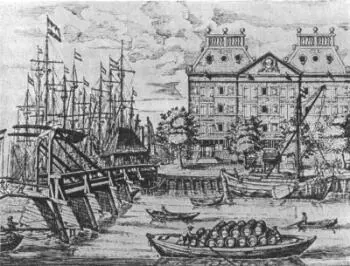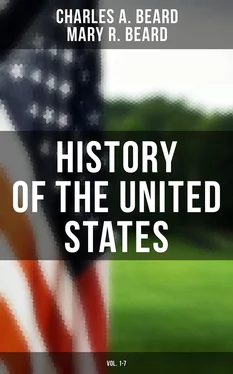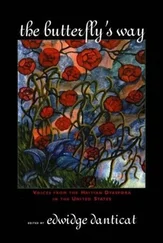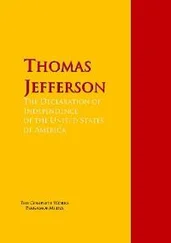1 ...6 7 8 10 11 12 ...31 The disposition of imported goods in the colonies, though in part controlled by English factors located in America, employed also a large and important body of American merchants like the Willings and Morrises of Philadelphia; the Amorys, Hancocks, and Faneuils of Boston; and the Livingstons and Lows of New York. In their zeal and enterprise, they were worthy rivals of their English competitors, so celebrated for world-wide commercial operations. Though fully aware of the advantages they enjoyed in British markets and under the protection of the British navy, the American merchants were high-spirited and mettlesome, ready to contend with royal officers in order to shield American interests against outside interference.

The Dutch West India Warehouse in New Amsterdam (New York City)
Measured against the immense business of modern times, colonial commerce seems perhaps trivial. That, however, is not the test of its significance. It must be considered in relation to the growth of English colonial trade in its entirety—a relation which can be shown by a few startling figures. The whole export trade of England, including that to the colonies, was, in 1704, £6,509,000. On the eve of the American Revolution, namely, in 1772, English exports to the American colonies alone amounted to £6,024,000; in other words, almost as much as the whole foreign business of England two generations before. At the first date, colonial trade was but one-twelfth of the English export business; at the second date, it was considerably more than one-third. In 1704, Pennsylvania bought in English markets goods to the value of £11,459; in 1772 the purchases of the same colony amounted to £507,909. In short, Pennsylvania imports increased fifty times within sixty-eight years, amounting in 1772 to almost the entire export trade of England to the colonies at the opening of the century. The American colonies were indeed a great source of wealth to English merchants.
Intercolonial Commerce.—Although the bad roads of colonial times made overland transportation difficult and costly, the many rivers and harbors along the coast favored a lively water-borne trade among the colonies. The Connecticut, Hudson, Delaware, and Susquehanna rivers in the North and the many smaller rivers in the South made it possible for goods to be brought from, and carried to, the interior regions in little sailing vessels with comparative ease. Sloops laden with manufactures, domestic and foreign, collected at some city like Providence, New York, or Philadelphia, skirted the coasts, visited small ports, and sailed up the navigable rivers to trade with local merchants who had for exchange the raw materials which they had gathered in from neighboring farms. Larger ships carried the grain, live stock, cloth, and hardware of New England to the Southern colonies, where they were traded for tobacco, leather, tar, and ship timber. From the harbors along the Connecticut shores there were frequent sailings down through Long Island Sound to Maryland, Virginia, and the distant Carolinas.
Growth of Towns.—In connection with this thriving trade and industry there grew up along the coast a number of prosperous commercial centers which were soon reckoned among the first commercial towns of the whole British empire, comparing favorably in numbers and wealth with such ports as Liverpool and Bristol. The statistical records of that time are mainly guesses; but we know that Philadelphia stood first in size among these towns. Serving as the port of entry for Pennsylvania, Delaware, and western Jersey, it had drawn within its borders, just before the Revolution, about 25,000 inhabitants. Boston was second in rank, with somewhat more than 20,000 people. New York, the "commercial capital of Connecticut and old East Jersey," was slightly smaller than Boston, but growing at a steady rate. The fourth town in size was Charleston, South Carolina, with about 10,000 inhabitants. Newport in Rhode Island, a center of rum manufacture and shipping, stood fifth, with a population of about 7000. Baltimore and Norfolk were counted as "considerable towns." In the interior, Hartford in Connecticut, Lancaster and York in Pennsylvania, and Albany in New York, with growing populations and increasing trade, gave prophecy of an urban America away from the seaboard. The other towns were straggling villages. Williamsburg, Virginia, for example, had about two hundred houses, in which dwelt a dozen families of the gentry and a few score of tradesmen. Inland county seats often consisted of nothing more than a log courthouse, a prison, and one wretched inn to house judges, lawyers, and litigants during the sessions of the court.
The leading towns exercised an influence on colonial opinion all out of proportion to their population. They were the centers of wealth, for one thing; of the press and political activity, for another. Merchants and artisans could readily take concerted action on public questions arising from their commercial operations. The towns were also centers for news, gossip, religious controversy, and political discussion. In the market places the farmers from the countryside learned of British policies and laws, and so, mingling with the townsmen, were drawn into the main currents of opinion which set in toward colonial nationalism and independence.
CHAPTER III
SOCIAL AND POLITICAL PROGRESS
Table of Contents
Colonial life, crowded as it was with hard and unremitting toil, left scant leisure for the cultivation of the arts and sciences. There was little money in private purses or public treasuries to be dedicated to schools, libraries, and museums. Few there were with time to read long and widely, and fewer still who could devote their lives to things that delight the eye and the mind. And yet, poor and meager as the intellectual life of the colonists may seem by way of comparison, heroic efforts were made in every community to lift the people above the plane of mere existence. After the first clearings were opened in the forests those efforts were redoubled, and with lengthening years told upon the thought and spirit of the land. The appearance, during the struggle with England, of an extraordinary group of leaders familiar with history, political philosophy, and the arts of war, government, and diplomacy itself bore eloquent testimony to the high quality of the American intellect. No one, not even the most critical, can run through the writings of distinguished Americans scattered from Massachusetts to Georgia—the Adamses, Ellsworth, the Morrises, the Livingstons, Hamilton, Franklin, Washington, Madison, Marshall, Henry, the Randolphs, and the Pinckneys—without coming to the conclusion that there was something in American colonial life which fostered minds of depth and power. Women surmounted even greater difficulties than the men in the process of self-education, and their keen interest in public issues is evident in many a record like the Letters of Mrs. John Adams to her husband during the Revolution; the writings of Mrs. Mercy Otis Warren, the sister of James Otis, who measured her pen with the British propagandists; and the patriot newspapers founded and managed by women.
The Leadership of the Churches
In the intellectual life of America, the churches assumed a rôle of high importance. There were abundant reasons for this. In many of the colonies—Maryland, Pennsylvania, and New England—the religious impulse had been one of the impelling motives in stimulating immigration. In all the colonies, the clergy, at least in the beginning, formed the only class with any leisure to devote to matters of the spirit. They preached on Sundays and taught school on week days. They led in the discussion of local problems and in the formation of political opinion, so much of which was concerned with the relation between church and state. They wrote books and pamphlets. They filled most of the chairs in the colleges; under clerical guidance, intellectual and spiritual, the Americans received their formal education. In several of the provinces the Anglican Church was established by law. In New England the Puritans were supreme, notwithstanding the efforts of the crown to overbear their authority. In the Middle colonies, particularly, the multiplication of sects made the dominance of any single denomination impossible; and in all of them there was a growing diversity of faith, which promised in time a separation of church and state and freedom of opinion.
Читать дальше













